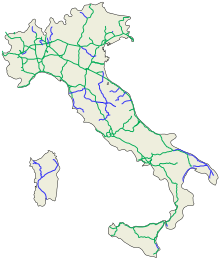
Roads in Italy are an important mode of transport in Italy. The classification of the roads of Italy is regulated by the Italian traffic code, both from a technical and administrative point of view. The street nomenclature largely reflects the administrative classification. Italy is one of the countries with the most vehicles per capita, with 690 per 1000 people in 2010.[1][2]
Italy has a total of 487,700 km (303,000 mi) of paved roads, of which 7,016 km (4,360 mi) are motorways, called autostrade, with a general speed limit of 130 km/h (81 mph), which since 2009 was provisioned for extension up to 150 km/h (93 mph).[3] The speed limit in towns is usually 50 km/h (31 mph) and less commonly 30 km/h (19 mph). The Strade Statali (Italian for "state highways") is the Italian national network of state highways. The total length for this network is about 25,000 km (16,000 mi).[4] The routes of some nowadays Strade Statali derive from ancient Roman roads, such as the Strada statale 7 Via Appia, which broadly follows the route of the Roman road of the same name.
Strade Regionali (Italian for "regional road") are a type of Italian road maintained by the regions they traverse. A regional road is less important than a state highway, but more important than Strade Provinciali (Italian for "provincial road"). A Strada Provinciale is an Italian road that is maintained by provincess or metropolitan cities. A Strada Provinciale is less important than a regional road, but more important than Strada Comunale (Italian for "municipal road"). Strada Comunale is maintained by comune, hence the Italian name. They can be roads owned by comune (inside population centers) or roads managed by the comune (outside population centers).
Italy was the first country in the world to build motorways reserved for fast traffic and for motor vehicles only.[5][6] The Autostrada dei Laghi ("Lakes Motorway"), the first built in the world, connecting Milan to Lake Como and Lake Maggiore, and now parts of the Autostrada A8 and Autostrada A9, was devised by Piero Puricelli and was inaugurated in 1924.[6] Piero Puricelli, a civil engineer and entrepreneur, received the first authorization to build a public-utility fast road in 1921, and completed the construction (one lane in each direction) between 1924 and 1926. Piero Puricelli decided to cover the expenses by introducing a toll.[7]
- ^ Sousanis, John (15 August 2011). "World Vehicle Population Tops 1 Billion Units". Ward AutoWorld. Archived from the original on 27 August 2011. Retrieved 27 August 2011.
- ^ See also: List of countries by vehicles per capita
- ^ Art. 142 Traffic Regulation
- ^ "Anas S.p.A. - Consistenza" (in Italian). Retrieved 19 March 2024.
- ^ Cite error: The named reference
independentwas invoked but never defined (see the help page). - ^ a b Cite error: The named reference
motorwebmuseumwas invoked but never defined (see the help page). - ^ Cite error: The named reference
aacawas invoked but never defined (see the help page).
© MMXXIII Rich X Search. We shall prevail. All rights reserved. Rich X Search
